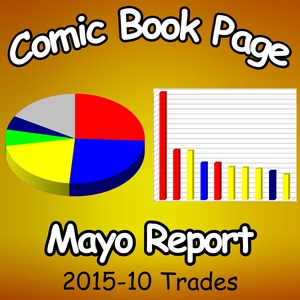Mayo Report for 2015-10

|

|
Top Comics List Top Comics Breakdown Top Trades List Top Trades Breakdown
October 2015 was a strong month due mainly on the strength of Marvel sales. Not only did Marvel take all ten slots in for the first time since January 2005 but another 8 slot of the top 20. The unit sales for Marvel within the top 300 was the highest it has ever been at 4,174,721 units, topping the previous high point in December 2008 by a little over 20,000 units. DC, on the other hand, sold 1,975,093 units within the top 300 comics which is below their average of 2,353,258 during the final order era which began in March 2003.
Marvel accounted for 52.67% of the total unit sales of the top 300 comics, DC another 24.92% and all of the other publishers accounted for the remaining 22.4% of the unit sales. This is the highest percentage of the top 300 comics unit sales Marvel has had since December 2009 when it had 52.62%. The highest percentage of the unit sales for the top 300 Marvel has ever had was 55.57% in June 2009 with 3,648,665 units. It is worth noting that Marvel's highest percentage of the top 300 unit sales was obtained with 526,056 fewer units than Marvel sold in October 2015. The clearly illustrates the percentage breakdown of the top 300 comics unit sales and the overall market breakdown are useful metrics only within a given month. Comparing those percentages between months cannot reliably determine if sales went up or down. The highest percentage of the unit sales for top 300 comics any publisher has ever had is 56.07% by DC in October 2011. In that month, DC had both the second issues of the New 52 relaunched titles and reorders of every one of the first issues except for "Men of War".
There were 14 comics over 100,000 units which is the most items over that benchmark since May 2007 which had 15 titles. June 2006 hold the record for the most items selling more than 100,000 units with 18 such items. June 2006 was the second month of the Civil War event and the "52" series as well as having first issues of "Wonder Woman," "Flash, The Fastest Man Alive" and "Eternals." Of those issues, three were the final remaining issues of "Journey to Star Wars: The Force Awakens: Shattered Empire." Another seven were first issues, most on that in a minute. Only three of the items, "Secret Wars" #6," "Star Wars" #10 and "Batman" #45 are likely to have similar sales on the following issue. The result is most of those high sales are unlikely to be repeated next month.
Marvel had 28 first issues in October 2015 with average sales of 108,388 units. Four of those first issues ("Spider-Gwen," "Uncanny Avengers," "Unbeatable Squirrel Girl," "Marvel Universe: Guardians of Galaxy") were the second first issue for the title within 2015. Topping the sales for Marvel in October was "Invincible Iron Man" #1 with an unsustainable 279,513 units. How do we know it is unsustainable? First off, nothing other than "Batman" has been able to sustain sales over 100,000 for over a year. Second, and more importantly, "Invincible Iron Man" #2 was at rank 28 with 66,664 units which is a drop of 76.15% from the first issue. The second best seller for Marvel was "Amazing Spider-Man" #1 with 245,873 units. At rank 10 was "Amazing Spider-Man" #2 with 111,321 units which is a drop of 54.72%. Continuing on with a few more titles with both the first and second issues released in October, "Captain America: Sam Wilson" #1 sold 62,534 units followed by a drop of 35.68% to 40,224 units on the second issue. "Spider-Man 2099" #1 sold 57,718 units and then dropped 29.48% to 40,701 units with the second issue. The average second issue drop for a mainstream Marvel title in October was 43.94%. Marvel is scheduled to have two dozen first issues in November and another 13 in December. We'll have a lot more data points for second issue drop on Marvel titles in the next few months.
One of the reasons the second issue drops are so large at Marvel is the promotional push on the first issues. "Invincible Iron Man" #1 had at least 10 variant covers beyond the regular cover while the second issue only had two variant covers. "Amazing Spider-Man" #1 had 11 variant covers while the second issue of that title only had two. "Captain America: Sam Wilson" #1 had four variant cover and the second issue had two. "Spider-Man 2099" #1 had three variant covers and the second issue only two. That smaller gap in the number of variant covers between the first and second issue is part of why the drop on those two titles wasn't as large as it was for the ones with close to a dozen variant covers on the first issue and a fraction of that on the second issue.
Collectability is a major sales factor and a much larger one than is healthy for the industry. The revenue stream created by variant covers is non-trivial. In addition to the first issue variants there is the themed variants. Over at DC, many titles has Monster theme variant covers. Given sales were down on almost every DC title in October, it stands to reason the Monster theme variants were not as popular as the Green Lantern 75th Anniversary themed covers in the previous month. Perhaps the Looney Tunes variants will do better in November.
There is a percentage of these sales we see every month caused by these variant covers. How big of a percentage is challenging to determine from the data Diamond releases. The retailers and publishers should have a better idea how large that percentage is for their part of the marketplace. If the collectability bubble bursts, as it did in the 1990s, that percentage of the sales, however large it is, could go away rapidly. Along with it could go another percentage of sales for the items those collectors were actually reading should those people leave the hobby entirely. With Marvel titles averaging 61,393 units, DC titles averaging around 25,988 units and other publishers averaging around 10,749 units in October, what percentage of sales is too much to lose? Keep in mind the average sales of month is for the best month Marvel has had in the last dozen years and is far from a typical month. In September, Marvel averaged 34,695 units. Hopefully that show how big of a different relaunching titles with numerous variant covers can makes.
Over on the trades list, the first trade paperbacks of "Star Wars" and "Star Wars: Darth Vader" came out and took the top two slots with 21,826 units and 10,142 units respectively. The first trade of "Star Wars" sets a new opening month sales record for a Marvel trade during the final order era. The previous best selling Marvel trade during a single month was the "Civil War" trade paperback in April 2007 with 19,215 units. The strength of the Star Wars franchise on the trades list should help Marvel on that side of things where they have a lower percentage of the sales in the top 300 trades than DC two thirds of the time.
